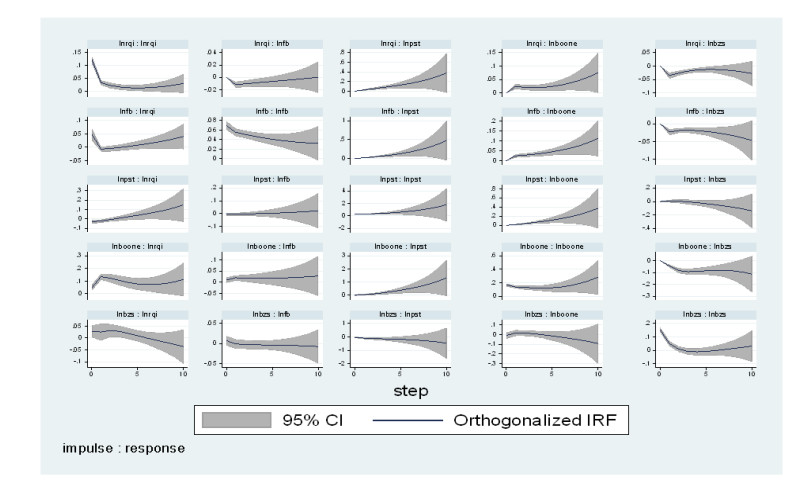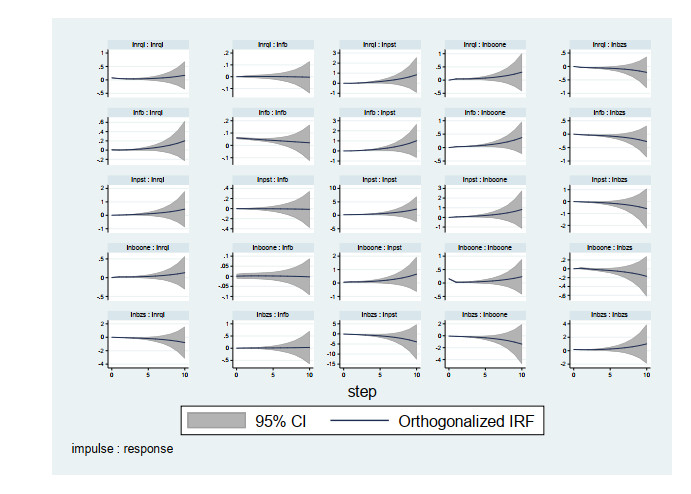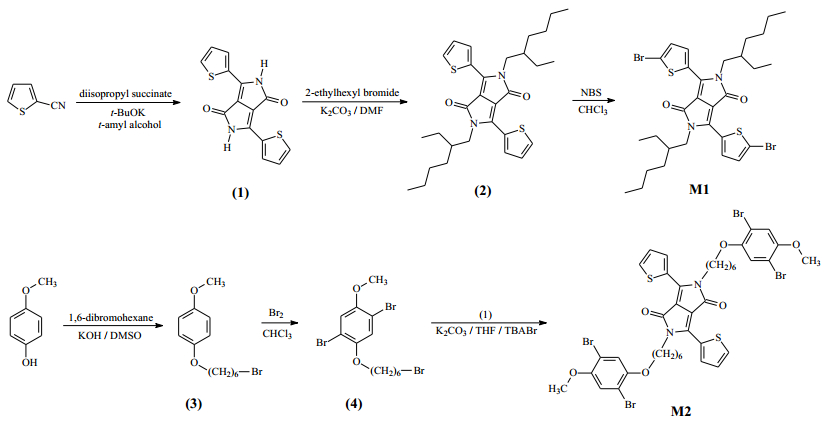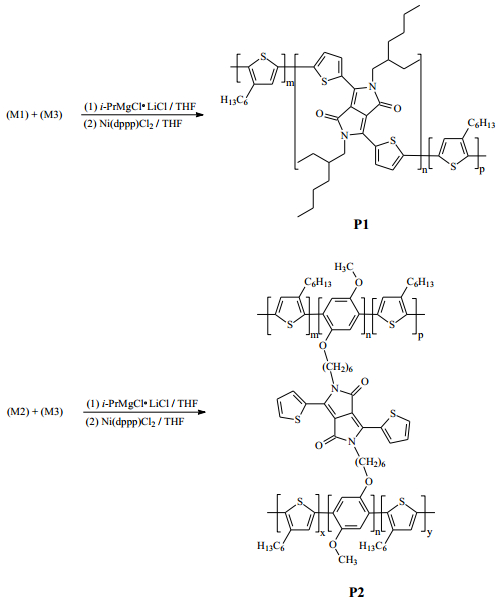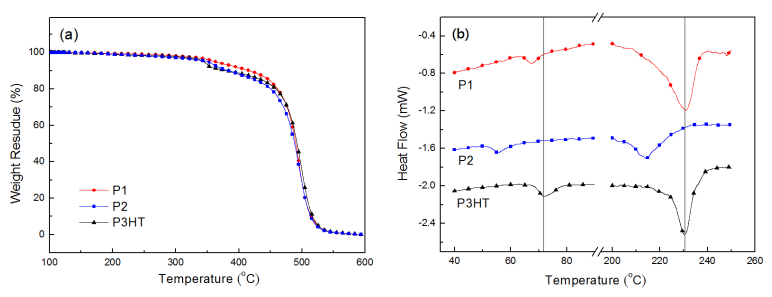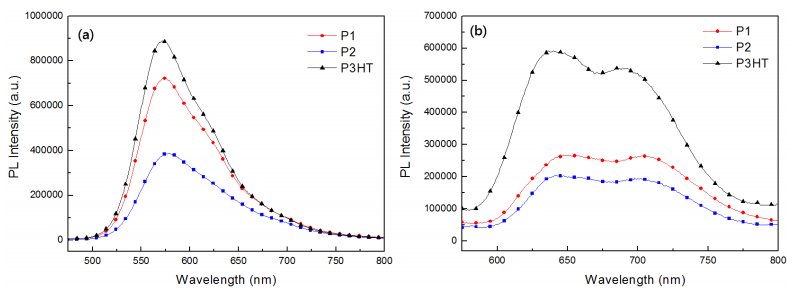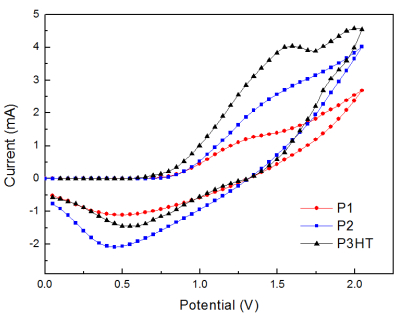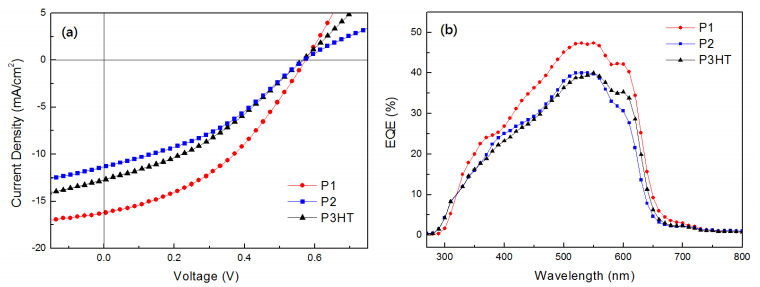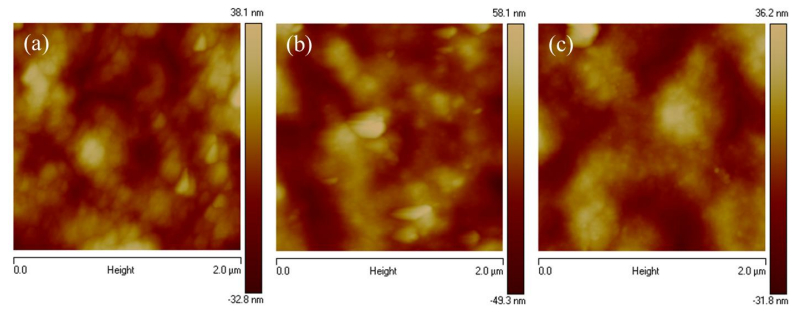Two novel polythiophene derivatives with linear or hyperbranched architectures using diketopyrrolopyrrole (DPP) as linking groups as well as normal poly(3-hexylthiophene) (P3HT) were synthesized via the Universal Grignard metathesis polymerization. The molecular weights of the linear polythiophene containing DPP linking moieties are higher than those of P3HT, while molecular weights of the hyperbranched one are smaller. The main decomposition temperatures of polymers were measured at 470 °C from TGA experiments. The UV-vis absorption behaviors of the DPP-containing polymers are similar to that of P3HT; moreover, these DPP-containing polythiophenes show distinct PL decay both in solution and thin film states. The electrochemical experiments reveal that the incorporation of DPP groups resulted in lowering HOMO levels of polymers. All polymers were blended with PC61BM and used as active layers for the fabrication of inverted polymer solar cells. The power conversion efficiency of devices based on linear and hyperbranched polythiophenes reached 3.74% and 2.38%, respectively, revealing comparable or even higher efficiency than the one based on normal P3HT.
1.
Introduction
Globally, financial stability has been a topic of major discussions among scholars. In the course to ensure stability, many authors have studied the factors that affect stability (Brunnermeier et al., 2009; Ozili, 2018). For instance, Brunnermeier et al. (2009) established that the Global Financial crisis in 2008–2009 and many domestic crises in the banking system around the world could be attributed to fragile regulatory systems and systemic dependence among banks. They further explained that such interdependence among the banks may have adverse effect on banking stability for which Africa is included. However, current studies have also linked banking competition as a determinant that significantly impact on the stability of banking systems (Kasman and Carvallo, 2014; Kasman and Kasman, 2015; Lucotte, 2017; Clark et al., 2017; Ahi and Laidroo, 2019).
Over the years, there has been significant reforms in banking sectors due to the many banking crises in African countries which have brought the stability of banking systems in Africa into focus (Ozili, 2018). These reforms led to the liberalization of interest rates and credit markets (Fosu, 2013). In recent times, the increase in these reforms have led to opening of markets which has significantly increased the presence of foreign banks in the region particularly in West Africa (Allen et al., 2011). The growing presence of foreign banks has significantly reformed banking in Africa, whilst promoting competition and innovation (Nyantakyi and Mouhamadou, 2015).
Though, competition in the banking industry will lead to greater efficiency and encourage innovation (Claessens, 2009; Fiordelisi and Mare, 2014), however, banking competition when not regulated by the appropriate regulators is likely to cause shocks to banks. Therefore, this has been the concern of policymakers, scholars, regulators, and investors, mostly following the global financial crisis, when competition was found to be fundamental to the crisis (OECD, 2010).
Due to this, the effect of competition on banking stability is still an ongoing debate among academic scholars and policymakers. Existing banking literature on the association of bank competition and stability reveals different results. Though, theoretical and empirical literature have shown a negative link between bank competition and stability. Thus, more competition decreases the stability of banks and hence leads to the fragility of the banking system (Carletti, 2008; Albaity et al., 2019). Contradicting theoretical models argues that increase in competition improves the stability of banks, hence, increases the overall stability of the banking system (Boyd and De Nicoló, 2005; Martínez-Miera and Repullo, 2010; Clark et al., 2018; Moyo, 2018).
Empirical evidence on the relationship in Africa is limited. Most of the studies undertaken in the region employed country-specific data and tested only competition (Simbanegavi et al., 2012; Osuagwu and Nwokoma, 2017). Simpasa (2011) and Sanya and Gaertner (2012) revealed that African banks exhibit monopolistic competition behaviours, failing to explore the relationship between banking competition and bank stability. Fosu (2013) completed a sub-regional study in Africa and evaluated the overall degree of banking competition. Employing the Panzar-Rosse model and the findings revealed monopolistic competition exist in each of the sub-regions (West, East, South and North). However, the study did not pay much attention to the influence of banking competition on bank stability.
The objective of this study is to investigate the relationship between banking competition and stability of the banking system in West Africa by employing the Boone indicator as a reliable and comprehensive indicator for competition. While some scholars may choose one measure of banking competition over the others, there is no agreement concerning the best way to measure competition. However, Carbo-Valverde et al. (2009) and Liu et al. (2013) explains that the different measures indicators of banking competition do not offer the same explanations about competition. Several studies have used either the Herfindahl-Hirschman index (HHI) or Lerner index and the Panzar and Rosse H-statistics (Berger et al., 2009; Agoraki et al., 2011; Beck et al., 2013; Liu et al., 2013; Samantas, 2013; Soedarmono et al., 2013; Claessens and Laeven, 2004). The Lerner index and the Panzar-Rosse model have been described as a static measure of competition and also based on the oligopoly theory. However, Bikker et al. (2012) and Clerides et al. (2014) have revealed that Panzar Rosse model for measuring banking competition seems to be invalid because it cannot reliably detect the actual degree of market power.
Again, many authors have argued that the Lerner index must not be used as a measure of market power because it does not capture the tendency of monopolistic competition (Elzinga and Mills, 2011; Wheelock and Wilson, 2012; Hughes and Mester, 2013; Beccalli et al., 2015). The Boone indicator, also a non-structural measure of competition, does not focus on the static analysis of the market and was developed with the objective to overcome the limitations of the standard market concentration measures (Herfindahl-Hirschman index, market shares of top3, or top5 banks) or non-structural measures such as Panzar and Rosse H-statistic and Lerner index.
The Boone indicator associate a bank’s performance with efficiency (Boone et al., 2005; Boone, 2008; Diallo, 2015). According to the Boone’s model (Boone, 2008), efficient firms achieve higher market shares and/or profits and this effect will be stronger in the environment where the competition is more intense.
A number of studies in banking literature have applied the Boone indicator in recent times (Schaeck and Cihák, 2014; Tabak et al., 2012; Kick and Prieto, 2015; Lapteacru, 2017; Ahi and Laidroo, 2019). Again, in our study, the variables are endogenous (Schaeck and Cihák, 2014), therefore we examined the relationship using Panel Vector Autoregression as the appropriate estimation model.
Our study contributes to literature in so many ways. The application of the Boone indicator has its own theoretical advantages, however only Dwumfour (2017) has applied the Boone indicator in Africa. Therefore, our study contributes to literature by extending existing knowledge in the application of the Boone indicator. Secondly, unlike the study conducted by Fosu (2013) which only focused on assessing banking competition in the sub-regions in Africa, our study reveals the true impact of competition on stability indicating that competition is a major determinant of stability in West Africa. Hence, extends African literature on the association between bank competition and stability.
Our results confirm that competition has a positive relationship with stability in West Africa signifying that greater competition improves stability. Thus, the result provide support for the competition-stability view. The PVAR estimate and granger causality test revealed that there is a consistent effect between banking competition and stability indicating that competition influences stability likewise stability will influence future competition. The result from the impulse response function points out that competition is a key determinant of stability in West Africa. Again, the study revealed that the relationship between banking competition and stability is bidirectional.
The remainder of this paper is structured as follows. Section 2 reviews the theoretical and empirical literature on banking competition and stability. Section 3 presents the methodology used in the study. Section 4 considers the empirical results and discussions. Section 5 presents the conclusion and recommendation of the study.
2.
Literature
2.1. Theoretical literature
The competition-stability nexus is ambiguous and there has been an ongoing debate among academic scholars and policymakers. Even though, a great number of different theoretical and empirical studies have given clarifications on the ways through which bank competition can have an effect on bank stability (Boyd and De Nicol'o, 2005; Keeley, 1990; Leroy and Lucotte, 2017; Ahi and Laidroo, 2019), however some authors have argued that whether competition is necessary for the stability of banking system is quiet problematic (Carletti, 2009; Kasman and Carvallo, 2014).
There are two theories in banking literature regarding the association between bank competition and stability namely “competition-fragility” and “competition-stability”. The competition-fragility theory argues that higher competition in the banking industry causes banks to lose their market power, and subsequently lead to a decline in the banks profit margins. Keeley (1990) shows that higher competition leads to a decline of a bank charter values, which result in an increase in default risk. This view is heavily supported by numerous theoretical and empirical studies (Smith, 1984; Hellmann et al., 2000; Matutes and Vives, 2000). Therefore, banks are likely to invest in riskier portfolios to improve and avoid bankruptcy. Thus, this can lead to the destabilization of banks (Keeley, 1990; Allen and Gale, 2000; Hellmann et al., 2000).
According to Boyd and De Nicol'o (2005), however, the link between competition and stability is positive. Boyd and De Nicolo (2005) argue that market power causes bank portfolio risks to increase. The seminal work of Martinez-Miera and Repullo (2010) offers support for the study of Boyd and De Nicolo’s (2005). They stated that the existence of risk-shifting effect indicating high interest rate in less competitive increases the risk of loans. However, this is likely to lead to bank bankruptcy. Martinez-Miera and Repullo (2010) further revealed that high bank interest rates increases banks’ profits. Thus, suggesting that the relationship between competition and the risk of bank failure as U-shaped. Empirical evidence has produced different findings on the impact of bank competition on stability (Berger et al., 2009; Tabak et al., 2012; Beck et al., 2013).
2.2. The relationship between bank competition and stability
Several empirical studies have attempted to investigate the association between bank competition and stability. These studies have yielded varying results. One strand of literature supports the competition-stability view and on the other hand, competition-fragility view is also well supported by empirical literature. This makes the relationship ambiguous.
A great number of banking literature provide support for the competition-stability theory (Noman et al., 2017; Clark et al., 2018; Ahi and Laidroo, 2019; Moyo, 2018; Alam et al., 2019). They have argued that competition is necessary for stability of banking systems. Leroy and Lucotte (2017) in their study assessed the effects of competition in the financial sector using banking data from Europe. Employing Z-score, systemic dimensions of risk and the Lerner index, they shown that greater competition reduces financial instability. Thus, their result denied the existence of a possible trade-off between competition and stability.
Schaeck and Cihák (2014) studied the influence of bank competition on banking stability using Boone Indicator as a competition measure and a sample of banks in Europe. They found out that competition is stability-enhancing. They further revealed that bank competition has a greater positive and significant impact on healthy banks than for unhealthy banks.
Again, Shijaku (2017) examined the relationship between competition and bank stability using a sample from Albania over the period of 2008–2015. The study employed three measures of competition (Herfindahl-Hirschman index, Boone indicator and Lerner index) and the GMM estimation method. Overall, the study revealed findings that support competition-stability view. Yaldiz and Bazzana (2010) concentrating on the Turkish banking system provided evidence which supports the competition-stability view. Similarly, Goetz (2017) also found support for the competition-stability view. The author asserted that more competition tend to reduce the probability of banks’ failure, ratio of non-performing loans and increases profit margins.
On the other hand, studies also offer empirical evidence for the competition-fragility view where greater competition hinders stability of banking systems (Fungáčová and Weill, 2013; Saif-Alyousfi et al., 2018).
Ahmed and Mallick (2017) in their paper empirically investigates the relationship between competition and bank risk from 2004–2013 with a sample of European listed banks. Their results indicate that competition encourages banks to take up more risks which further increases individual bank fragility. This result largely supports the “competition-fragility” view.
Similarly, Turk-Ariss (2010) studied the effect of banking competition on stability in developing countries using dynamic panel model for estimation and found evidence that supports the competition fragility view. The study further highlighted that greater market power improves stability and profit efficiency.
The study of Diallo (2015) used 145 countries over the period 1997–2010 to investigate the association between banking competition and stability. The study employed the Boone indicator, the Lerner and the adjusted Lerner indices as measures of banking competition and Z-score as a proxy for stability. Using logistics probability analysis, the results revealed that banking competition is damaging to stability, hence providing support for the traditional competition-fragility view.
In a dual banking perspective, some authors have attempted to study the association between banking competition and stability (Abedifar et al., 2013; Beck et al., 2013; Čihák and Hesse, 2010). Empirical evidence on the link between banking competition and stability in the context of dual banking system tends to support the competition-fragility view (Kabir and Worthington, 2017; Risfandy et al., 2018).
Recent empirical literature on the effect of bank competition on stability has shown mixed results. Berger et al. (2009) conducted a study with a sample of 8235 banks from 23 developed economies and their results that support both the competition-fragility view and competition-stability view. They pointed out that banks with greater market power in the banking system may have riskier loan portfolios, however, these risks can be traded off with higher capital ratios or other techniques of risk-mitigation.
Liu and Wilson (2013) assessed the impact of bank competition on stability with a Japanese sample. Based on the characteristics of banks, the results from their study show that competition is good for banks with low stability level, but harmful to banks with higher stability level.
Tabak et al. (2012) focused their study on 10 Latin American countries from 2003 to 2008 and found evidence that supports non-linearity relationship between competition and risk-taking. Their study suggest that either low or high competition increases bank stability, however, in a banking system moderate competition exist, stability decreases.
A great number of studies have also attempted to test the non-linearity relationship between banking competition and stability (Noman et al., 2017; Shijaku, 2017; Lapteacru, 2017; Tabak et al., 2012). Though some studies supports the argument of Martínez-Miera and Repullo (2010) that a non-linear relationship exist between banking competition and stability (Jimenez et al., 2013; Liu et al., 2013), the findings of Shijaku (2017) found no supportive evidence in an attempt to capture a potential non-linear relationship between competition and stability.
From literature, it is evident that the linear relationship between bank competition and stability has been either positive or negative and also most of the studies were conducted in Europe, Latin America or Asia with little focus on Africa. The few studies conducted in Africa gave little attention to banking competition-stability relationship and therefore could not provide a clear picture on the influence banking competition can have on stability.
Again, these empirical studies used either the OLS regression, system General Method of Moments or Dynamic Panel Data which do not give a good picture of how the variables behave and the output over the years. This leads to inconsistency in the findings of these studies.
Thus, supporting the claims of Bushman et al. (2016) who attributed the differences in the results from theoretical and empirical literature on the sample used, and also the period given. Additionally, Pawlowska (2016) states that this is due to the inappropriate indicators used to capture banking competition and stability.
3.
Methodology
3.1. Variable description
We measure banking competition using the Boone indicator. The Boone indicator is based on profit-efficiency and calculated as the elasticity of profits to marginal costs. The more negative the Boone indicator, the higher the degree of competition indicating a strong effect of reallocation. Therefore, an increase in the Boone indicator suggests that the competitive conduct of banks has worsened.
Again, in this study, we use Bank Z-score as the indicator for bank stability. Bank Z-score has been used by many authors on the relationship between competition and stability (Louati and Boujelbene, 2015; Fiordelisi and Mare, 2014; Leroy and Lucotte, 2017). It is calculated as (ROA+ (equity/assets))/sd(ROA); sd(ROA) is the standard deviation of Return on Assets (ROA). Z-score compares the buffer of a country’s commercial banking system (capitalization and returns) with the volatility of those returns. Higher values of Z-score indicate greater stability.
For statistical accuracy, we included control variables such as presence of foreign banks, and institutional factors namely regulatory quality index and political stability and absence of terrorism. We define presence of foreign banks as the ratio of foreign owned banks to the number of the total banks in an economy. According to the World Bank, a bank is termed as a foreign bank when its shares owned by foreigners is 50 percent or more. Hermes and Lensink (2004) argues that existence of foreign banks strengthens the financial intermediation process by providing new innovations in technologies and also new products and services in the banking industry. They further argued that, this improves the stability of the banking system. Therefore, in our study, we expect positive relationship between presence of foreign banks and stability.
Many studies have shown that institutional quality can have an impact on the stability of banking system (Demirguc-Kunt and Detragiache, 1997). Similarly, Beltratti and Stulz (2012) and Klomp and De Haan (2014) have argued that the governance quality of a country may have an effect on banking regulation and supervision which can further influence the behaviour of banks (Ozili, 2018). In our study, we included institutional quality factors such as regulatory quality index and political stability and absence of terrorism. Therefore, we expect a positive relationship between these variables and stability. The table below (Table 1) shows the variables used in the study.
3.2. Sample and data
This study focuses on the sample of 10 West African countries over the period 2000–2014. The countries in the sample are Benin, Burkina Faso, Cote D’ivoire, Ghana, Mali, Mauritania, Nigeria, Senegal, Sierra Leone, Cape Verde, The Gambia, Guinea, Niger and Togo. The selection of these countries were based on data available for the sample period. However, due to unavailability of data, six (6) countries in the region were excluded from the sample. Annual data on Bank Z-score were obtained from World Bank whereas data on Boone indicator retrieved from St. Louis Federal Reserve Bank database of World Bank from the period of 2000–2014. We also included control variables such presence of foreign banks, regulatory quality index and political stability and absence of terrorism to achieve statistical accuracy and reduce the possibility of endogeneity problem. The data for these control variables were retrieved from the World Bank.
3.3. Econometric modelling
For the purpose of this study, we used the panel vector autoregressive (PVAR) model for estimations through the GMM framework employed by Love and Zicchino (2006).
3.3.1. Panel Vector Autoregressive (panel VAR) model
In our study, we use the panel VAR approach due to heterogeneity in our data. The PVAR model takes heterogeneity into account and thus increasing consistency and coherence measurement. According to Canova and Ciccarelli (2013), variables are treated endogenous and interdependent in PVAR model, both in dynamic and static cases. However, in some instances, exogenous variables can be included. Thus, the panel VAR model is suitable for examining both exogenous and endogenous shocks in estimations. Again, with respect to interdependence, the panel VAR treats all variables in the model as endogenous and does not differentiate between endogenous and exogenous variables. Therefore, each variable individually relies on the historical understanding and other variables that show the coexistence among the variables and how they are treated. The general formula for panel VAR by Love and Zicchino (2006) is denoted as:
where Yit is the vector of endogenous stationary series variables of bank z-score (lnbzs), Boone indicator (lnboone), regulatory quality index (lnrqi), presence of foreign banks (fb) and political stability and absence of terrorism (lnpst). The country-specific fixed effects matrix is denoted as ui and the polynomial matrix in the lag operator with A(L)=A1L1+...+AP−1LP−1+APLP is denoted as A(L). ai captures individual heterogeneity or fixed-effects between different cross-sectional units, δt represents the country-specific time dummy variables, and ɛi, t denotes idiosyncratic errors, with E(εi,t)=0,E(ε′i,tεi,t)=∑ and E(ε′i,t)=0 for t > j. Equation 1 can be specified to reflect systems of equations involving the variables of the study as:
Although Equation 2 is our main equation for this study, we further estimate the equations for the remaining variables to know their reactions in the model estimation process. In the panel VAR model estimation process, it is important to obtain the stationarity of the series and the selection of optimal autoregressive lag-length (j).
In the application of panel VAR model, there are some limits on the parameters. However, these limitations can be taken care of with the presence of certain variables. Therefore, at level, the introduction of fixed effect (αi) into the model accounts for individual heterogeneity to overcome these limitations. Again, we included country-specific fixed effects (µi) in the model to capture all the time factors that are not observed at the country level. However, the introduction of µi in the model creates challenges in the estimation process, and the problem of slowness lags of the dependent variable in any model specification.
Overall, the panel VAR helps to analyze the effects of orthogonal shocks and explain the level of impact of shocks from one variable to the other while at the same time maintaining unchanging variables in the model. This result can be attained through the application of panel impulse response functions (IRFs), since it accurately defines the reaction of one variable in respect to changes of other variables over time, at the same time maintaining all other shocks constant.
4.
Results and discussions
4.1. Descriptive results
The result in Table 2 shows the descriptive statistics for the study. The results reveal that Boone indicator as a measure of competition, has a negative mean (M = −0.116, SD = 0.245) indicating that there is high competition in West Africa. Again, bank stability proxied by bank Z-score has a positive mean (M = 2.484, SD = 0.549). The results further show that there is a huge variation in the bank Z-score for countries in West Africa from 1.211 to 3.759. Thus, explaining that the stability in the region appears to be stable for the period given.
The results in Table 3 illustrate the correlation matrix and collinearity statistics. This is mostly used to check the possibility of multicollinearity between the variables. The results show no extremely correlation among the repressors. Again, the Tolerance result from the collinearity statistics for all the variables is greater than 0.2. Similarly, the VIF result for each variable is less than 5. This further explains that there is no multicollinearity in the model.
4.2. Unit roots tests
In this study, we perform unit root tests to determine the stationarity of the variables which is an important precondition in the implementation of panel VAR estimations. We applied both first and second generation unit root tests. The first generation unit root tests cross sectional independency whereas the second generation unit root test overcomes the limitations in the application of first generation unit roots test. Im et al. (IPS) (2003); Choi (2001); and Maddala and Wu (1999) are the first-generation tests and take into account cross-sectional independency. The second-generation tests include Pesaran (2007); Moon and Perron (2004) and Choi (2002) and they also take into account cross-sectional dependency and heterogeneity. The second generation tests is deemed appropriate when there is cross-sectional dependency. Thus, Pesaran (2007), IPS (2003) and Fisher type (Maddala & Wu, 1999; Choi, 2001) were used to test the stationarity of the series. This is because these unit roots tests have the ability to test for the null hypothesis in the series. Furthermore, these tests are appropriate as they allow for heterogeneous panels.
The result in Table 4 shows that all the variables in the panel contain unit roots, at the level except presence of foreign banks Again, from the table, the results reveal that all the variables are stationary at first difference and integrated of order I(1). Thus, rejecting the null unit root hypothesis at 1% significance level. These results further prove that panel VAR model estimations are necessary.
4.3. Panel VAR estimates
From Equation 2 and the optimal lag selected, panel VAR model for the first order lag is estimated using GMM style. The result from the estimation of the panel VAR equation is presented in Table 4.
For the bank Z-score equation, the result shows that the first order lags of all the variables have a significant impact on bank stability at a 1% significance level except political stability and absence of terrorism which was insignificant. The significant and negative coefficient of the Boone indicator signifies a positive link between competition and stability. This implies that competition is beneficial to the stability of banking system, given that lower values of the competition measure (Boone indicator) indicate more competition. This finding supports the studies of Risfandy et al. (2018), Ahi and Laidroo (2019) and Schaeck and Cihák (2014) who found out that increased competition improves stability, however contradicts with the findings of Shijaku (2017) and Goetz (2017) who found out that more competition is harmful to stability. Again, regulatory quality index also decreases stability. La Porta et al. (1997) argued that good institutions increase financial development and therefore we expect a positive relationship between regulatory quality index and stability. However, from the table, the relationship is negative. This further proves that West Africa has weak regulatory controls thereby decreasing stability in the industry. According to Hermes and Lensink (2004), the presence of foreign banks is likely to improve the performance of banks. This can further have an impact on the financial system stability, implying that there should be a positive relationship between presence of foreign banks and stability. However, from the table there is a negative relationship between presence of foreign banks and stability (bank Z-score). This implies that presence of foreign banks in the region decreases stability of the banking system. Also, the lag of political stability and absence of terrorism is insignificant and does not influence stability. This explains that political stability and absence of terrorism does not increase or decrease stability in West Africa. This result tend to contradict the argument Demirguc-Kunt and Detragiache (1997) who showed that institutional quality significantly impact on the fragility of a banking system in a country. Concerning Boone equation, the lags of all the variables have a significant and positive influence on the Boone indicator at 1% significance level. The Boone indicator is positively influenced by its own lag at 1% significance level. For the political stability and absence of terrorism equation, the lags of regulatory quality index, and presence of foreign banks influence political stability and absence of terrorism positively at 1% significance level while it is influenced negatively by the Boone indicator at 1% significance level. Again, it significantly influences its own lag at 1% significance level.
Similarly, the equation for the regulatory quality index (RQI), the lags of bank Z-score and Boone indicator significant and positively impact on regulatory quality index at 5% and 1% significance level respectively. The lags of political stability and absence of terrorism and presence of foreign banks impact on regulatory quality index at 5% and 1% significance level respectively. For presence of foreign banks equation, the lag of Boone indicator has a positive impact at 1% significance level while the lag of regulatory quality index has a negative significant impact on the presence of foreign banks at 1% significance level. However, lags of bank Z-score and political stability and absence of terrorism do not have influence on regulatory quality index. This indicates that competition proxied by Boone indicator and the presence of foreign banks in West Africa influences the decision on regulatory policies. Therefore, it is appropriate to include the impulse function in our study to show the graphical analysis of the response of a variable to the other over the given period. Overall, the results revealed that banking competition significantly affects the stability of the banking system and that the association between banking competition and bank stability is positive. Hence, the findings of this study support the competition-stability view of where greater competition improves stability (Moyo, 2018).
4.4. Granger causality test
In this study, we employ the Wald test by Abrigo and Love (2015) to estimate the granger causality among the variables. From the estimation, the null hypothesis indicates no causality.
The result in Table 6 indicates the existence of bidirectional relationship among the variables. The explanation is that one variable can influence another variable, and the same variable can be influenced by other variables too in the model. For instance, the relationships between bank z-score and Boone indicator, bank z-score and regulatory quality index, Boone indicator and regulatory quality index, Boone indicator and presence of foreign banks, political stability and absence of terrorism and regulatory quality index, and regulatory quality index and presence of foreign banks are all bidirectional. In this model, Boone indicator influences bank Z-score, and bank Z-score also influences the Boone indicator indicating that a higher competition increases stability, providing support for the competition-stability view. Again, this means that an increase in stability increases future banking competition explaining that a stable banking system promotes healthy competition in the banking sector.
Similarly, the result indicates that regulatory quality index granger causes bank Z-score and bank Z-score granger causes regulatory quality index. This can further be explained that regulatory quality index increases stability in the region given that good regulatory frameworks tend to enhance stability. Hence, provide support for the study of Brunnermeier et al. (2009) who revealed that banking crises happen when there exist ineffective regulatory controls.
Also, from Table 6, the relationship between bank Z-score and political stability and absence of terrorism, bank Z-score and presence of foreign banks, Boone indicator and political stability and absence of terrorism, and political stability and absence of terrorism and presence of foreign banks are unidirectional. For instance, presence of foreign bank has an influence on stability, however, stability do not have an influence on presence of foreign banks. We can conclude that presence of foreign banks is a key factor that influences stability in West Africa.
4.5. Variance decomposition
In this paper, we further estimate the variance decomposition technique in respect to the degree of impact variations in one variable on other variables as well as the degree of these effects. The result from the orthogonalized impulse response is presented in Table 6. For the purpose of this study, we concentrate on the 10th period to explain the error variance decomposition. That is, the variables have the maximum explanatory power of the other at that period.
The result in Table 7 indicates that competition (Boone indicator), political stability and absence of terrorism, regulatory requirement index and presence of foreign banks approximately describe 50%, 22%, 5%, and 3% respectively of the variations in stability (bank Z-score). This further explains that although all the variables have an influence on stability, however, competition proxied by Boone indicator has a greater influence on the stability of banking system in the region. Thus, confirming that banking competition is one of the main determinants of banking stability. Also, bank Z-score causes 3% while political stability and absence of terrorism causes 44% variations in Boone indicator. In the same equation, regulatory requirement index has 2% and presence of foreign banks show 5% variations in Boone indicator. This means that institutional quality in the form of political stability and absence of terrorism explain greater percent of changes in competition in West Africa than the remaining variables which account for 5 percent or less. This further shows that when African countries in the region are political stable, it tends to improve the stability of banking system through healthy banking competition. That is, banks have the ability to function well in the region without any distractions or problems fueled by political constraints. On the other hand, when the countries are politically unstable, it affects the activities of banks as well as the behaviour of customers. This leads to changes in the competitive behaviours of banks and at the end could disrupts stability in the banking system. Bank Z-score, Boone indicator, regulatory requirement index and presence of foreign banks 4%, 28%, 3% and 4% respectively of the variations in political stability and absence of terrorism. These variables each causes less than 30 percent changes in political stability and absence of terrorism. Again, regulatory requirement index, political stability and absence of terrorism, Boone indicator, bank Z-score 2%, 3%, 14% and 1% respectively of the variations in presence of foreign banks. Finally, there is 23% variation of political stability and absence of terrorism in regulatory requirement index, 58% variation of Boone indicator in regulatory quality index, 3% variation of bank Z-score, and 3% variation of presence of foreign all in regulatory requirement index. Explaining the variance decomposition of Boone indicator to Z-score, our result indicates that competition in West Africa has a better ability to explain the variation of stability, when using Z-score. That is, banking competition could be viewed as an important determinant of stability in the region. Overall, the result suggests that greater competition in the region improves stability, thus, supporting the seminal work of Boyd and De Nicol'o (2005) who found out that there is a positive relationship between competition and stability.
4.6. Impulse response
Relying on Cholesky decomposition and the Sims’ (1980) suggestions, we tested the orthogonalized IRF’s of shock. In analyzing the impulse response functions, it was imperative to use the Gaussian approximation to estimate the confidence intervals on the basis of Monte Carlo simulations with 500 replications with 5% error bands.
The result from the impulse response function indicates that the impact of one standard deviation shock in the rise of Boone indicator as a proxy for banking competition on stability (bank Z-score) was zero from the first year and dropped to negative through to the tenth year. This result provides support to the studies of Yaldiz and Bazzana (2010) and Goetz (2017) who found out that greater banking competition improves stability.
4.6.1. Robustness test
In our study, we used a first order of the PVAR model in order to test the robustness. Again, we used another form of PVAR which operates without the GMM style. The result is presented in Table 7.
From Table 8, for our main equation, the result shows competition variable proxied by Boone indicator is significant and has a negative coefficient. This explains that the banking system in the region is competitive given that the more negative the Boone indicator, the higher the degree of competition. The result from the impulse response function indicates that the impact of one standard deviation shock in the rise of Boone indicator as a proxy for banking competition on stability (bank Z-score) was zero from the first year and decreased throughout. This is shown in the figure below.
Overall, the result from the PVAR estimate and impulse response function is consistent with the result in Table 5.
5.
Conclusion
This study examined the relationship between banking competition and stability of banking system in West Africa for the period 2000–2014. In the process, we considered banking competition variable Boone indicator and Stability variable bank Z-score. In addition, we also included control variables such as political stability and absence of terrorism index, regulatory quality index and presence of foreign banks. Using a panel data, we employed the PanelVector Autoregression model to estimate the result because this model has a greater ability to predict accurately given that the variables involved are seen as endogenous based on empirical literature. Again, we estimated the impulse response functions and variance decompositions to assess the relationship between competition and stability.
The PVAR estimation technique revealed that there is a consistent granger causality effect between banking competition and stability pointing out that competition is a key determinant of stability in West Africa. Again, the study revealed that the relationship between banking competition and stability is bidirectional.
The variance decomposition and the impulse function also revealed that the presence of foreign banks has an adverse effect on stability, as well regulatory controls are quite weak in the region which reduces the stability in the region. That is, in the absence of banking competition, these explanatory variables make the banking system fragile. Therefore, policy makers and governments must regulate the entry policies of new banks as Kabir and Worthington (2017) stated that a stable banking system could possibly attract new banks and promote competition when evidence shows that too much competition could damage stability. Again, they must strengthen their regulatory and supervisory controls to monitor activities of banks that may likely distract future stability in the region.
Overall, we recommend that countries in West Africa implement stability-enhancing policies when it is evident that competition increases stability in the region.
Acknowledgement
We are much grateful to one anonymous referee for his valuable comments and suggestions which has helped us to improve substantially the quality and clarity of this work. The usual disclaimer apply.
Conflict of interest
All authors declare no conflict of interest in this paper.









 DownLoad:
DownLoad:
